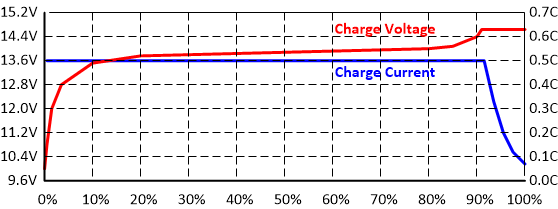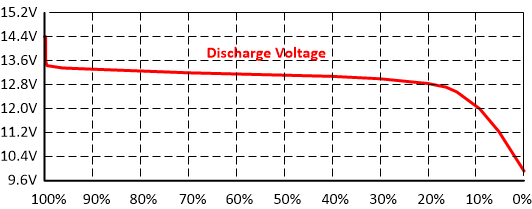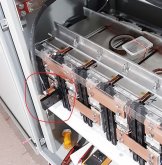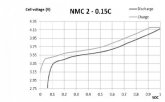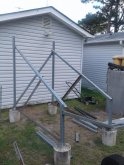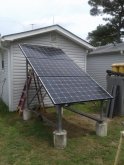EDIT: just remembered you are using EV batteries, so they probably are not lifepo4. I'm not sure how this will apply to NMC or whatever battery chemistry you are using.
my cells indicate Lithium-ion
[/QUOTE]
Most likely they are a Cobalt type which run a little higher voltage than the LiFePo4 (aka LFP) most people like to use. The LFP type does have several advantages. They will not catch fire. They can handle more charge cycles. They have a flatter voltage curve. And they act more like Lead Acid so charger settings are a bit easier. Their only real disadvantage is they have a lower energy density than the Cobalt variants. So for the same power the pack will be larger and heavier, but for a system sitting in a home, it is not a big problem. And the difference is not all that big either. LFP are also a little bit lower voltage. A typical "48 volt" system is 16 cells with LFP, where a LiIon with Cobalt only needs 14 cells to get a good typical "48 volt" pack.
My LG Chem Chevy Bolt batteries, are technically Li NMC (Lithium, Nickle, Manganese, and Cobalt). There are a few other varieties. The less Cobalt, the less likely to burst into flames, but less energy per volume and mass as well. Li NMC is one of the safer Cobalt designs, and I have not seen any reports of a Chevy Bolt or Volt catching fire after a crash like we have seen in Teslas. I think the Nissan Leaf cells are between the Tesla and Bolt on the Cobalt scale.
If we are all careful and keep the cell voltages between the safe limits, and don't exceed the maximum charge and discharge rates, the cells are very safe and should provide several years of service without a problem. Each chemistry does have it's little differences in the charge characteristics, but they are all close enough that as long as we use a CC CV charge profile below the maximum, they will work without stressing the batteries. The cells for EV's now are being built to take huge power surges and fast charging to make the cars more like a gasoline car. So these cells are now able to crank out crazy short term current and then get charged to 80% in just 20 minutes. In our home storage use, we will never push the cells anywhere close to those numbers. Charging at over 30 amps and discharging up to 80 amps, my pack is dead cold, the same temp as the floor of my garage where they are located.
Any BMS that can monitor the cell voltages and disconnect the charge or load current if something goes out of range is all you really need to keep you safe. But you should not depend on the BMS to control the charge or discharge limits. I know my Schneider XW-Pro will throw errors and go offline if the BMS has to shut it down, but it won't damage anything. The only reason you need the BMS to communicate is to tell the inverter or charger to stop as there is a problem. If you are running the cells close to full and empty, this may be a helpful feature to keep the system from going into a shutdown with errors they may require a manual operation to get it back running again. When my XW saw a low battery condition, I had to clear the error before it would turn back on. If this was a remote cabin that was not occupied, it could be a serious problem. But if you leave the top 10% and bottom 30% by limiting the max charge and load run down, even if there is drift, this should not happen. The BMS should only come into play if something if failing and going bad, and it will save the pack and maybe prevent a fire. In which case, you will need to go there to find out and fix what went wrong anyways. So while it is nice to be able to monitor the battery bank, I don't feel it is truly necessary to have it talk to the inverter / charger. If you see it going out of the normal range, fix the issue before it goes far enough to shut it down.
A decent Basic BMS will still prevent a battery failure due to over/under charging any single cell. That is the whole point of having one. Even with no balance current, they should be able to do that. If it goes too far out of balance, it shuts down when a cell hits the safe limit. Add balance current, and it can prevent a nuisance shut down by helping keep the batteries from drifting out and hitting the limit. A "Smart" BMS can report and tell you how it is doing. Some also have temperature shut down for high temp, and some even do low temp protection. LFP cells can't be charged below freezing. This is all to protect the batteries. The harder you push the batteries, the more protection you might need to keep them safe. If everything goes well, the BMS should never need to shut anything down. The proper operation of the inverter / charger system should keep the batteries in a safe state. It should know to shut down if the pack is too hot or cold or if the total pack voltage is going out of range. It really can't do anything for a single cell problem. And that is where the BMS really comes in. A single cell going bad. It could be a failing cell or a connection that came loose. But it is a problem so having the system shut down makes sense. Fix the problem, don't make the inverter work around it.



